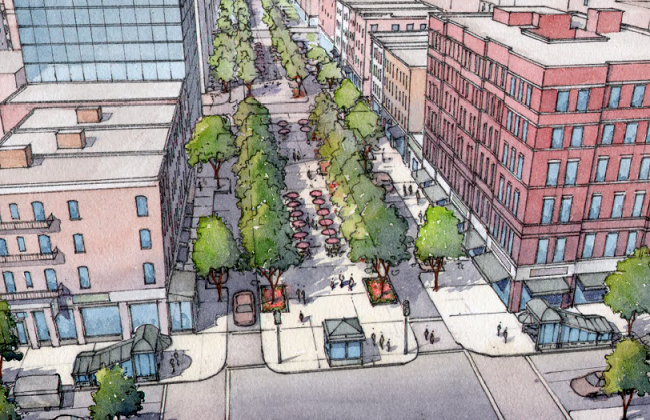A biweekly newsletter with public space news, resources, and opportunities.
A curated dispatch on all things public markets plus the latest announcements from the Market Cities Program.
2012 was a big year in general here at PPS—and the same was true for the Placemaking Blog! We've had a blast communicating with Placemakers around the world through our blog, as well as through Facebook and Twitter. And so, to end the year on a reflective note, we thought we'd put together a round-up of our top posts from the past year, organized by popularity. See anything you missed??

"In the last decade, some of the new buildings that have won the most acclaim exemplify what we might call a kind of new “Brutalism.” They recall that style’s monolithic disregard for human scale and for connection to the surrounding streetscape."

"Placemaking tosses out the idea that an architect or planner is more of an expert about how a place should be used than the people who are going to use it. By bringing people together around a shared physical place, it’s also a powerful tool for disrupting local complacency."

"While the best way to learn about what makes a great place is often to get out and observe how public spaces work first-hand, there are films that illustrate Placemaking principles quite beautifully."

"When we try to eliminate congestion from our urban areas by using decades-old traffic engineering measures and models, we are essentially using a rototiller in a flowerbed. And it’s time to acknowledge that the collateral damage has been too great."

"The design professions have been given free reign to set up a wholly dysfunctional system when it comes time to promote the best and brightest, and the results are devastating our public spaces...Whether [competition] jury members actually have to use the spaces that they praise is irrelevant. They are tastemakers, not Placemakers."

"[Public markets are especially viable] today because the global economy has skewered our sense of being able to support ourselves. Markets are very reassuring places, because they give you a sense of responsibility for your own health. People are experimenting, and reinventing what it means to have a good life."

"It is critical to remember, in any project, that you are creating a place, not a design. While good design is important to creating great places, it is but one tool in your kit–not the driving force behind good Placemaking."

"Making a great place requires lots of participation from lots of people. That creates lots of new Placemakers, and inspires a whole new group of zealous nuts. Placemaking can change the way that people think about their role within their community."

"Public spaces that are rich in Place Capital are where we see ourselves as co-creators of the most tangible elements of our shared social wealth, connecting us more directly with the decisions that shape our economic system."

"Although a lot of time and money was being put into large projects, they weren’t necessarily leaving behind streets that are better to grow a business on, or to make a home...We thought, ‘Why is that?’ It’s the Placemaking piece, actually."

"Shifting attitudes are chipping away at the austere walls of yesterday’s “culture ghettos,” with people demanding more inspiring, interactive gathering places. Creativity is becoming one of the most coveted social assets for post-industrial cities with increasingly knowledge-based economies–and this is good news for culture vultures and average Joes, alike."

"Many people have become so used to their surroundings looking more like a suburban arterial road than a compact, multi-use destination that they’ve become completely disconnected from Place. Real life is lived amongst gas stations and golden arches; we have to visit Disneyland to see a thriving, compact Main Street."
The rich text element allows you to create and format headings, paragraphs, blockquotes, images, and video all in one place instead of having to add and format them individually. Just double-click and easily create content.
The rich text element allows you to create and format headings, paragraphs, blockquotes, images, and video all in one place instead of having to add and format them individually. Just double-click and easily create content.
Body Text Body Link
The rich text element allows you to create and format headings, paragraphs, blockquotes, images, and video all in one place instead of having to add and format them individually. Just double-click and easily create content.
Here is some highlighted text from the article.




Headings, paragraphs, blockquotes, figures, images, and figure captions can all be styled after a class is added to the rich text element using the "When inside of" nested selector system.
Headings, paragraphs, blockquotes, figures, images, and figure captions can all be styled after a class is added to the rich text element using the "When inside of" nested selector system.
Headings, paragraphs, blockquotes, figures, images, and figure captions can all be styled after a class is added to the rich text element using the "When inside of" nested selector system.